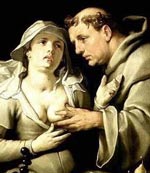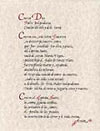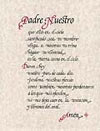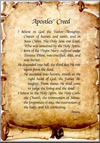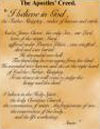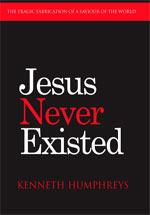A perk of orthodoxy?
Between the 2nd and 4th centuries the fable of Jesus was not even agreed by Christian bishops!
"Jesus still alive in the reign of Trajan" – said 2nd century bishop Irenaeus. [Trajan 98-117 AD]
"Jesus born before Herod the Great" – said 4th century bishop Epiphanius. [Herod 73-4 BC]
Acceptance of an historical Jesus by Christian communities, many of which had been established by the Gnostics, progressed slowly and erratically.
In different Christian communities different beliefs about Christ opposed and overlapped each other for many centuries.
At the forefront of rendering gnostic allegory into fake history was the Church of Rome.
Eventually the approved story would be hammered out at rancorous Church councils and codified into creeds to be learned by rote.
T & T
Timothy is said to have been a teenage assistant to Paul hired in Galatia. He seems to have had no say when his boss decided to circumcise him! (Acts 16.3)
His reports from Thessalonica. led to 1 Thessalonians.
The fanciful Acts of Timothy record the young hero's martyrdom (stoned and clubbed) by dastardly pagans at the Dionysian festival of Katagogia.
Titus was said to have been a Greek companion of Paul, sent as his representative to Corinth and taking 2 Corinthians with him. He was subsequently made "first bishop" to Crete.
His head – well, someone's head – turned up in 9th century Venice.
End to Free Speech?
"But avoid foolish questions, and genealogies, and contentions, and strivings about the law; for they are unprofitable and vain.
A man that is an heretick after the first and second admonition reject;
Knowing that he that is such is subverted, and sinneth, being condemned of himself."– Titus, 3.9,11.
Manicheans – "The Spirit Can't be Trapped."
The Manicheans, inspired by the 3rd century Persian mystic Mani (216-277), accepted Jesus as a spiritual leader but held to the gnostic idea that all matter was evil, trapping the divine spirit.
For them, the Christ could never have entered a human body. If he had done so he would have lost his power (a bit like Kryptonite proving fatal to Superman).
In other words, for these exotic Christians, Jesus and Christ were quite separate entities.
Mani himself was an early-day Muhammad, claiming he had received the 'final, universal revelation' and making his first converts within his family.
The cult spread from Persia to Syria, Palestine, India, and across north Africa, where it claimed its most famous convert (Saint) Augustine.
Manichaeism continued at least until the 7th century.
Arianism – "Jesus Neither God nor Man"
The movement led by the Alexandrian presbyter Arius (256-336) led to two centuries of internecine strife over the "true nature of the Lord."
Arius's Platonic logic convinced him (and many others, including the emperor Constantine) that Jesus was "similar to an angel, not human, but not quite God."
As ever, theological wrangling and power politics resolved the issue – not any recourse to historical fact.
Docetists – "Apparition of a man"
The Catholic Church, striving to eradicate their Gnostics rivals, coined the term "Docetists" (from the Greek "to seem") to describe those heretics who believed their Christ's divinity was irreconcilable with his taking human form.
A faint echo of this ancient skirmish is to be found in the First Epistle of John, a multi-author work put together by the orthodox:
"Many false prophets are gone out into the world. Hereby know ye the Spirit of God: every spirit that confesseth that Jesus Christ is come in the flesh is of God.
And every spirit that confesseth not that Jesus Christ is come in the flesh is not of God:
And this is that spirit of antichrist, whereof ye have heard that it should come; and even now already is it in the world."
– 1 John 4.1,3
Why would this epistle need denounce the deniers of a human Jesus other than because many Christians did, indeed, deny a human "Jesus of Nazareth."
Jerome?
(340-420)Expert linguist, Jerome was hired by the gangster pope Damasus to re-write the Bible.
His version, the "Vulgate", became the official edition up to the Renaissance.
Jerome also wrote a useful compilation of biographies De viris illustribus (On famous men).
Augustine?
(354-430)Superstar of the Latin Fathers, Augustine of Hippo wrote the "CIty of God" to absolve Christians from any blame for the fall of Rome.
He gave the Church much of its inhumanity and ruthlessness, with concepts of "original sin" and the use of force.
He also contributed the novel idea that Christianity pre-dates Christ!
"What we now call the Christian religion existed amongst the ancients, and was from the beginning of the human race, until Christ Himself came in the flesh; from which time the already existing true religion began to be styled Christian".
– St. Augustine (Retract., I, xiii, 3)
"Orthodoxy" (orthodoxeia) is
not a word to be found in scripture. Rather, it originated with
the organization of the Catholic Church. Thus, the 4th century
propagandist of the True Faith, St. Augustine, pronounced that:
Dogmas and creeds, learned by rote, displaced speculations on the divine. This sterile "sound doctrine" rejected and condemned the more esoteric notions advanced by rival factions and wild notions of egalitarianism, poverty and common property.
Orthodoxy and its Critics
It was only three centuries after the supposed "facts" of JC's life and teachings that rancorous assemblies of ambitious and fanatical clerics decided what precisely was that life and teaching. The distinction between orthodoxy and its opponents was never as clear cut as later 'official' Church historians were to maintain. Many so-called Gnostics had held positions of authority within the early Church, as did the Apologists later stigmatised as heterodox and heretical. Orthodoxy even appears to have had its own factions. The synoptic "12 Apostles and a ministry of 12 months" has a hint of gnosticism about it, connecting the superstar with the zodiac and astrology. A rival faction of the orthodox favoured a much longer ministry for their hero and a rebuttal of the more esoteric gnostic doctrines. Their ideas entered the canon in the Gospel of John. Orthodoxy favoured a set of simplistic tales, little more than "comings and goings" of the godman, comprehensible to the uneducated, and readily re-enacted in pageant and ceremonial. These fables were held to be "true accounts from recent history". In a series of councils and assemblies spanning two centuries, an officially approved and obligatory dogma was hammered out which was then stamped upon the credulous mind of humanity. Those with the temerity to question the creed and sacraments were criminalized, persecuted and eliminated.
The 2nd century literature of gnostic "romances" had proved immensely popular. Those close to the growing Church hierarchy plagiarised and edited these texts, purging them as best they could of gnostic esoterics and adding in the one message truly their own: obedience of the bishops. Paul's epistles had been compromised by 1st century Jewish Gnosticism. But in the mid-2nd century Marcion had appended them to his own (the original) gospel and were too widely known to be suppressed. The answer was new letters by "Paul", the so-called Pastoral Epistles, universally acknowledged to be spurious. The fake epistles use the device of "Timothy" and "Titus", companions of Paul, to instruct the brethren in how they were to organize the local Churches. They are, it seems, sent as bishops to Ephesus and to Crete where they exercise authority over both clergy and laity, guard "the purity of the Church's faith", and ordain priests. Unlike the original Pauline epistles the Pastorals exclude all reference to "spiritual gifts" (the tool of the apocalyptic sects) and concentrate instead on establishing a hierarchy of cadres.
Ignatius – Bishop with Attitude, First Voice of OrthodoxyThe Pastorals provided "scripture" which established divine approval of episcopal authority. The falsehood had now to be constructed that none less than the Apostles themselves had established that very hierarchy which led, in an unbroken line, to the entrenched authorities of the Catholic Church in Rome. For this the Epistles of St. Ignatius served the purpose. In official "Catholic history" Ignatius bears witness to the beliefs and organization of the early Christian church (which, of course, turns out to be all very Catholic and orthodox). And yet the unconvincing "celebrity tour and insistent martyrdom" of Ignatius conceals a more mundane reality: almost certainly Ignatius was an inconsequential Christian zealot from Syria who got himself executed in Rome. Half
a century later, one (or several) eminent churchmen of Asia
Minor used the dead
fanatic
as a prop for a
series of letters bringing church organizations and
wayward priests into the subordination of bishops. Ignatius himself
is made a disciple of the Apostles. The
fabrications also present an opportunity to colour in more
details of the Jesus fantasy and to fix the
godman himself in an historical past.
Again and again Ignatius asserts that the supremacy of the bishop is a divine institution. He goes so far as to affirm that the bishop stands in the place of Christ Himself!
These examples of mid-2nd century fraud were followed by others: "letters by Ignatius" were still being written into the 5th century! Irenaeus –"A 10+ year Ministry for Jesus, who Lived into Old Age!" This hero of Catholic orthodoxy made his reputation by castigating numerous 2nd century heresies which he called "diseases of the human mind". Heresy hunting became his life's work. Irenaeus attacked the "licentious practices" and "foolish doctrines" of the heretics – spread, it seems, by the aid of "silly women". But Irenaeus was not above a bit of Jesus fictionalising himself:
Storyteller Irenaeus was probably the author of the lurid account of the "sufferings martyrs" in his home city of Lyons. What better method to drum up sympathetic support than a bogus tale of heroics?
Cyprian Styled a "champion of Church unity" Cyprian coined the phrase:
Epiphanius of Salamis "Jesus Born about 100 BC"
For nearly forty years Epiphanius exerted his authoritarian influence across the eastern Mediterranean. From his see of Constantia (Salamis) on the island of Cyprus this senior bishop's distaste for the "poisons of heresy" and lust for power drove him to intervene in Antioch (against the Apollinarians, who said Jesus had no human soul once Christ had entered him); against Origenism in Jerusalem, with its allegorical interpretations of biblical events, and against Arianism everywhere. In fact, this notorious heresy hunter identified no fewer than 80 exotic and prosaic heresies, the remedy for which he set out in his "Medicine chest" ("Panarion"). Epiphanius, of course, knew the
"Truth" – which for him meant Jesus was born during
the reign of the Hasmonean
king Alexander Jannaeus, who ruled Judaea between 103-76 BC.
With the death of Alexander, power passed to his wife, Salome and when she died, a struggle for succession broke out between Jannaeus's two sons, John Hyrcanus II and Aristobulus II. In 63 BC Roman general Pompey arrived and confirmed Hyrcanus as high priest (63-40 BC) but real power passed to Antipater and Herod as client kings of Rome.
The A B C of Literalist Fraud "No Proof Needed – Miracles the Only Evidence."
Tellingly, when early Christian Apologists struggled to prove the "truth" of their beliefs they turned, not to contemporary evidence of Jesus’ existence – which surely they would have done if they could! – but to the prophets and psalms of the Old Testament. They cut verses out of context and altered them to make them appear to be speaking about Jesus. Later, with the 'Sayings tradition' taken from the Gnostics, pious fraudsters set the words into the vignettes plagiarized from the Old Testament. The multitude of micro-stories were then strung together in a meandering itinerary. The result was the Gospels, not historical documents, but catechisms, written for the sole purpose of inculcating faith. Only in a later age, when the Church had assumed the mantle of absolute power, would the Empty Tomb, the True Cross, the Apostles' bones and the rest of the paraphernalia of fraudulent "evidence" appear.
The Closed Mind, the Prison of Orthodoxy A pure and uncorrupted "orthodoxy" never existed, nor did it, with the Lord's guiding hand, convince the foolish of their errors by contending with wilful and perverse heresy. "Orthodoxy" eventually emerged from a plethora of competitive sects after a considerable and prolonged struggle. The story of the godman, never more than a disjointed pageant of heroic failure, ignominious death and an unfathomable godly rebirth, became the almost empty canvass upon which "schismatics, heretics, and apostates" painted a rich and variegated dreamscape of human suffering, sorrow and hope. Orthodoxy took time to get its act together, taking what it could use from the very sources it would later condemn. At first, only slowly did it marginalise and eliminate its critics. But the pace quickened once what became orthodoxy was empowered as the State/Church religion. Guided from the throne room and the palace, orthodoxy would fashion itself to the needs of the caesars, confirming it's role as the faith of empire, a Universal and Catholic faith. In the end only a narrow dogma remained, chanted and learned by rote.
Creeds – Pre-packed thinkingNicene creed
Sources:
Enlighten a friend e-mail this page
Copyright © 2005
by Kenneth Humphreys.
|
|||||||||||||||||||||||||||||||||||||||||||||||||||||||||||||||||
